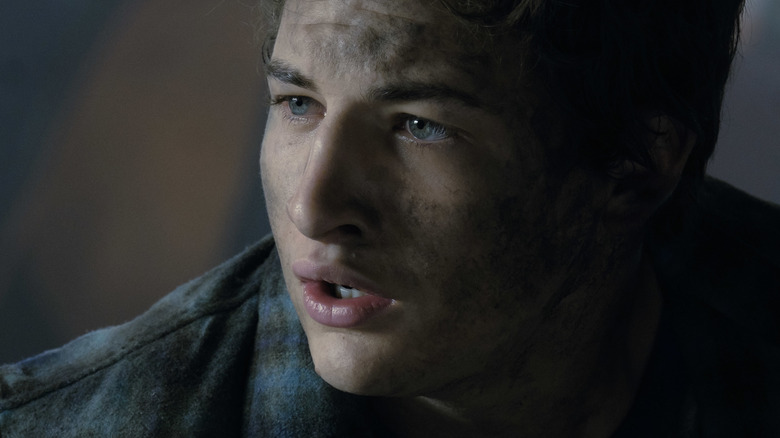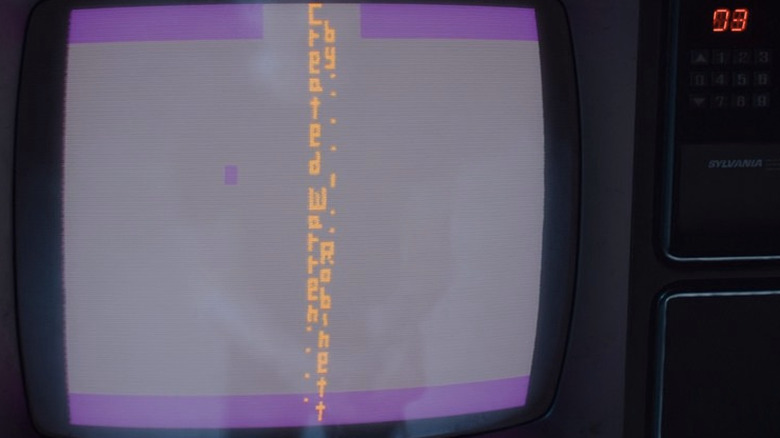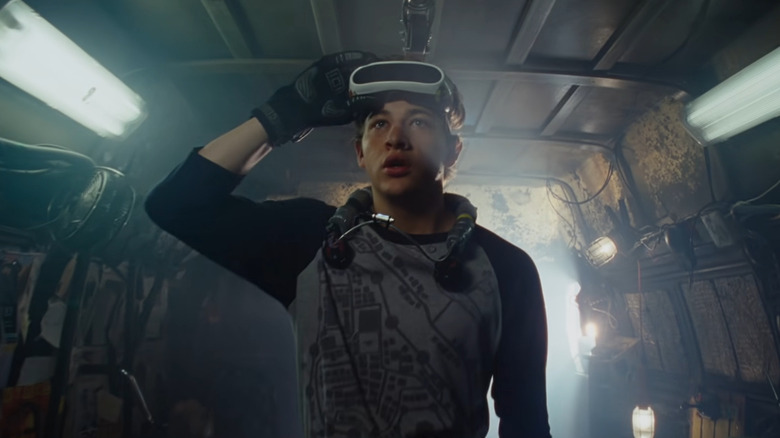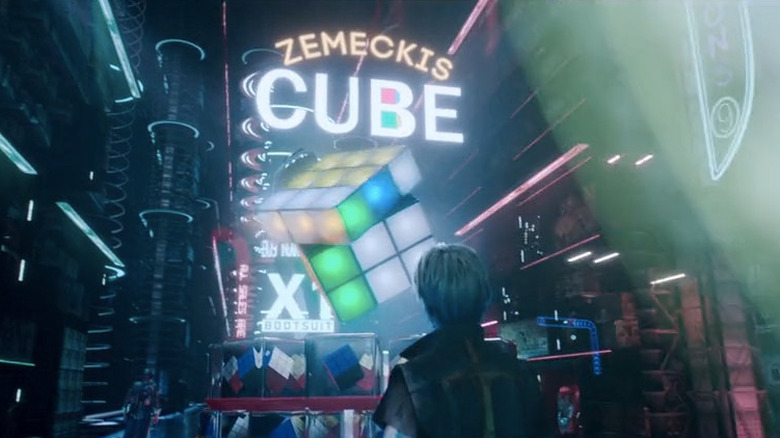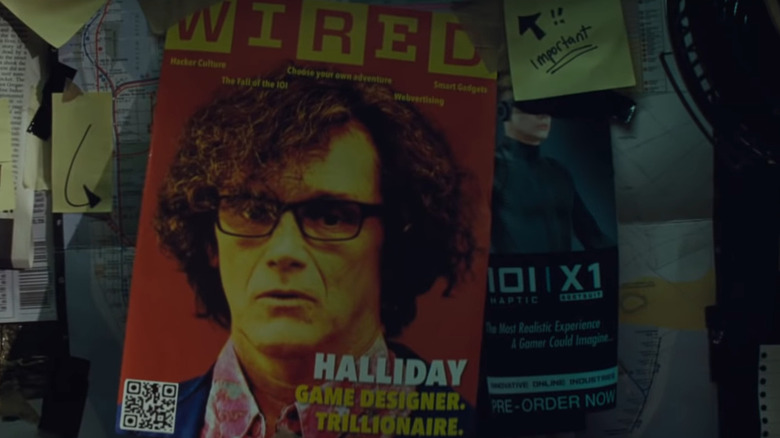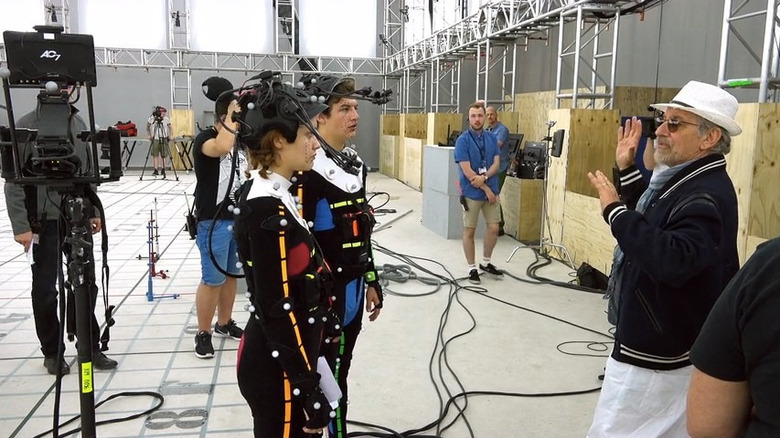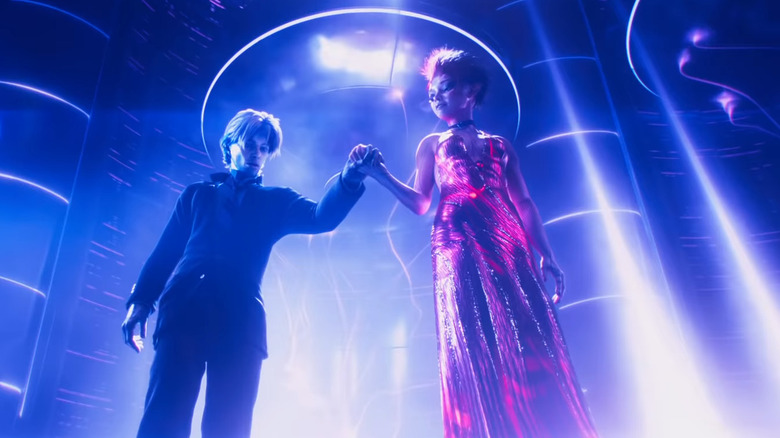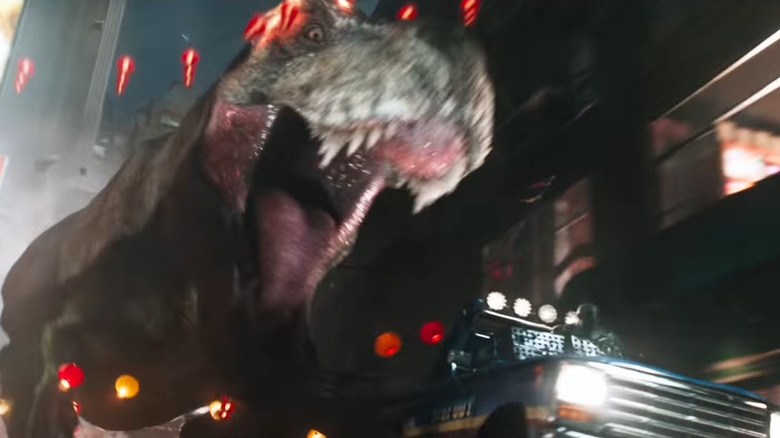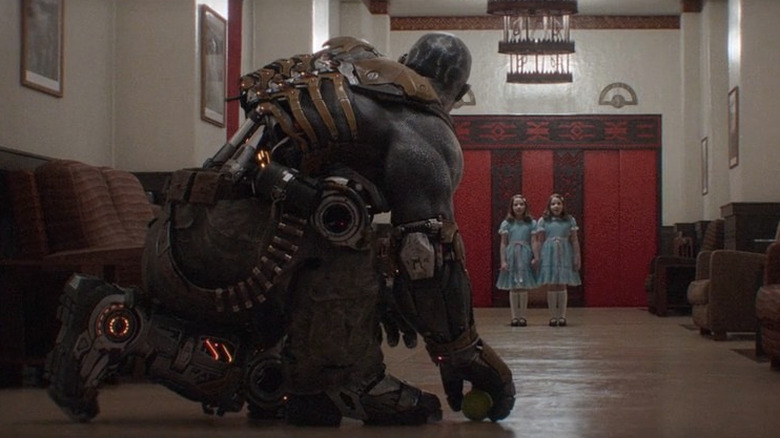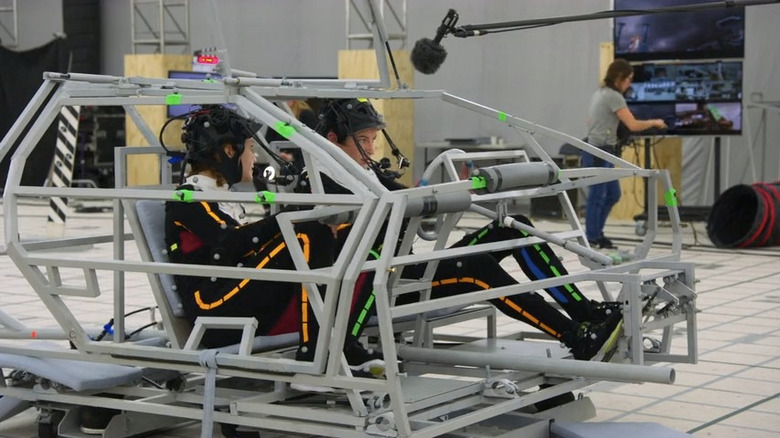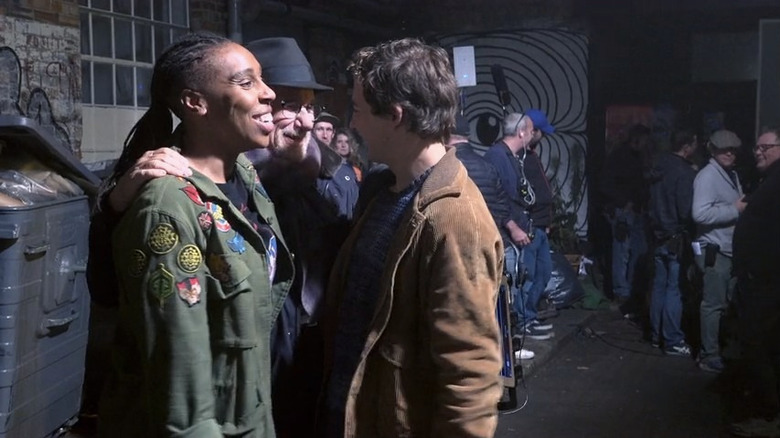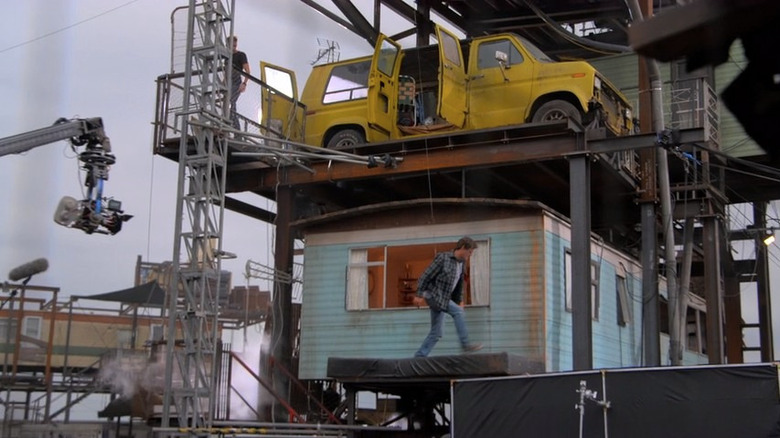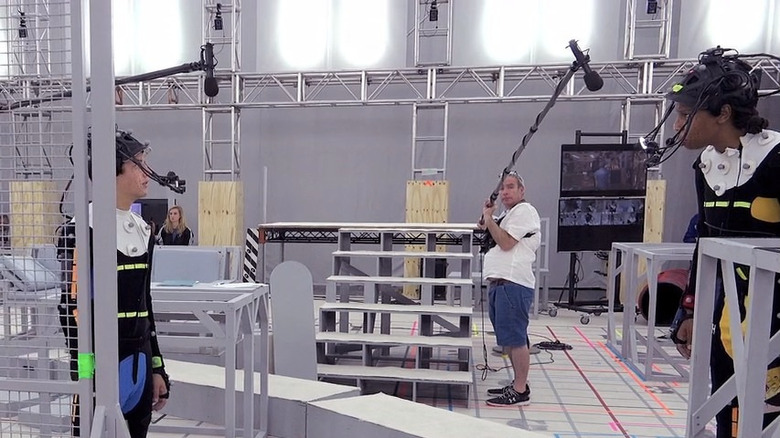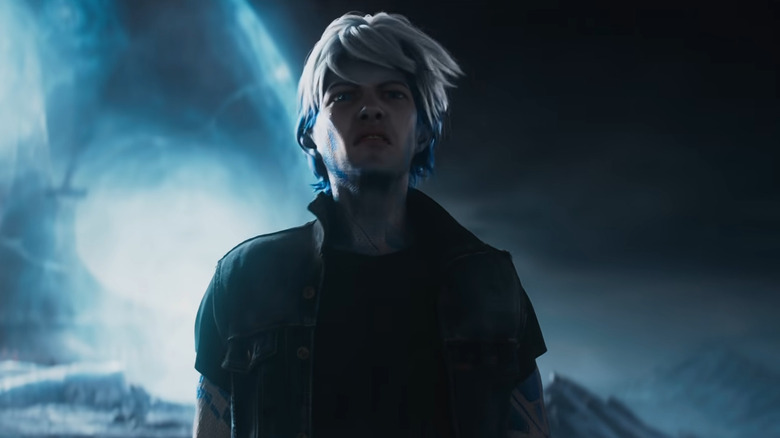Game On With These Ready Player One Facts Only Huge Fans Know
The meme of Leonardo DiCaprio from "Once Upon a Time in Hollywood" has become ubiquitous with film fans' passion for noticing hidden details in movies. The meme in question involves Rick Dalton, DiCaprio's character in the 2019 Quentin Tarantino film, pointing at his television screen as he sees himself on a TV show. The image of Dalton embodies many audience members' pride and enthusiasm upon watching a movie and discovering a well-placed reference to popular culture, realizing the meaning of a movie's title, or even recognizing an actor from another production.
With these parameters, the meme could pretty much be displayed for the entirety of "Ready Player One," the 2018 film directed by Steven Spielberg based on a 2011 novel by Ernest Cline. The story focuses on a future in which the entire world is obsessed with the pop culture of the 1980s. This premise naturally lends itself to a barrage of hidden tributes to the decade, some obvious and others hidden.
It certainly made for a unique production process for the film, which split its time almost equally between traditional photography and motion-capture sequences taking place in the OASIS, a virtual reality game. How did Spielberg, one of Hollywood's most prolific filmmakers, bring to life this futuristic wonderland that honored a decade he himself helped define? Let's find out.
The idea for Ready Player One came from unlikely inspiration
The future imagined by "Ready Player One" is so deep with lore that it's difficult to imagine how author Ernest Cline even began to establish the parameters of the story. In the documentary "Game Changer: Cracking the Code," Cline shares how he found his starting point from a unique pairing of seemingly unrelated entities of pop culture.
Cline always loved how videogame designer Warren Robinett hid his name in the Atari game "Adventure." The credit is considered to be the first videogame Easter egg. Also being a fan of Roald Dahl, Cline imagined a variation of "Charlie and the Chocolate Factory" that posed the question, "What if Willy Wonka had been a videogame designer instead of a candy maker?" Digging deeper, Cline then asked, "What if he held his golden ticket contest inside his greatest videogame creation?" This became the framework for "Ready Player One," in which James Halliday leaves behind his inheritance to the winner of a virtual reality quest consisting of challenges driven by hidden Easter eggs.
In "Game Changer," Cline says, "That got me excited because I realized that Halliday's passions in the story could mirror my own." Once Cline built out the story, the Robinett factoid became a major plot point and the key to Parzival winning the competition. Subsequently, the song "Pure Imagination" from "Willy Wonka and the Chocolate Factory," the 1971 movie adaptation of Dahl's book, was used during the 2018 promotional campaign for "Ready Player One."
There's a cinematic contrast between the real and virtual scenes
"Ready Player One" presents a future in which many citizens are so fully engrossed in the OASIS that they prefer the virtual world to reality, and spend much more of their time with a headset on than without. When bringing this idea to life visually in the movie, there would be no mistaking the virtual world for the real world. Scenes taking place in the OASIS look distinctly computerized, but could there be an added layer to the contrast between fake vs. real that would further emphasize this difference, even subtly? The answer to this question should make any movie fan geek out.
To add more visual difference between scenes taking place in reality and scenes taking place within the OASIS, director Steven Spielberg and director of photography Janusz Kamiński chose to shoot real-world scenes on film, according to the Hollywood Reporter. The old-school imperfections of analog production cleverly complement the sleek, pristine digital world in a way that adds texture to the movie's theme of a blemished reality being superior to a curated fantasy.
Alan Silvestri sampled his own music from Back to the Future
Steven Spielberg typically invites John Williams to score his movies, but Williams was too occupied with "The Post," another Spielberg film, to come onboard for "Ready Player One." Instead, Alan Silvestri composed the music, bringing experience from his work on a handful of the iconic '80s films that the story references. Silvestri, for example, wrote the famous score from "Back to the Future," a movie that "Ready Player One" nods to frequently. This came in handy when Silvestri received instructions from Spielberg around some of these moments of tribute: "I don't want it to sound like 'Back to the Future.' I want it to be 'Back to the Future.'" Silvestri relays charming anecdotes like this in the Blu-ray bonus feature "High Score."
Silvestri says, "It was great because I had met Steven many years ago, but had never worked with him in this way. It was a very thrilling event for me." Silvestri's participation was seemingly written in the stars. Wanting to be fully immersed in '80s pop culture, author Ernest Cline says he listened to Silvestri's soundtracks while writing the original "Ready Player One" novel.
Wes Anderson's production designer told the story in the details of the set
Adam Stockhausen, a frequent collaborator of Wes Anderson, was the production designer of "Ready Player One." Stockhausen's filmography includes such Anderson films as "Moonrise Kingdom" and "The Grand Budapest Hotel." He had also previously worked with Steven Spielberg on "Bridge of Spies." Speaking in the "Game Changer" documentary, Spielberg praises Stockhausen's "visionary" work on "Ready Player One," saying, "He already came from a highly stylized background and he took everything he ever learned in collaboration with Wes and brought it to us for 'Ready Player One.'"
Stockhausen filled the "Ready Player One" set with small details, like fictional newspaper clippings of Halliday's life on Wade's wall. These not only help build out the futuristic world of the film for eagle-eyed viewers, but also aid in immersing the cast and crew in the story while filming — something they surely appreciated in contrast to the digital motion-capture scenes, which were filmed on an empty set void of nearly any physical details.
After "Ready Player One," Stockhausen continued working with both Spielberg (on "West Side Story") and Anderson (on "Isle of Dogs" and "The French Dispatch," as well as the upcoming "Asteroid City" and "The Wonderful Story of Henry Sugar").
Ready Player One was filmed on a set with a magical history
"Ready Player One" was filmed at the UK's Leavesden Studios, where the "Harry Potter" movies were made. Steven Spielberg acknowledged this and compared the inherent fantasy of the two productions in a speech he gave to the cast and crew on day one of filming. It's tradition for Spielberg to prepare a toast on the first and last days of production for each of his movies.
"Being here at the 'Harry Potter' studio, you all know that what you see ain't what you get in the movie theater," Spielberg told the cast and crew on day one, as captured in the documentary "Game Changer: Cracking the Code." For "Ready Player One," the production began by filming all the scenes that take place in the OASIS, requiring actors to wear motion-capture suits, before filming anything that took place in the real world. Spielberg continued in his speech, "So you're gonna start in a very abstract world ... Feel free to look at the monitors to get an idea of the art direction and the direction that the movie is headed, but in the meantime, this is going to be a lot of interesting confusion, and that's a good thing. Hopefully, sparks will fly."
There were complications with motion capture
A huge portion of the movie was filmed using motion-capture technology, requiring special equipment to be attached to the actors' heads to record their facial expressions. This sometimes made it tricky to film intimate moments between Parzival and Art3mis as the two avatars of Wade and Samantha get to know one another inside the OASIS. One scene involves the pair of them going on a date to a dance club.
"We had to do this dance in the movie," actor Tye Sheridan told MTV in 2018, "and we had these prongs coming out from our headgear." Fellow cast member Olivia Cooke, sitting next to Sheridan in the interview and laughing, referred to the contraptions as their "antlers." Sheridan continued, "They had two cameras on them. It's supposed to be a very intimate scene and our faces are so close and it's like we're gonna kiss." The tenderness of the moment was interrupted, though, when their "antlers would get hooked together and someone would have to run in" and untangle them.
Steven Spielberg left out (most) references to his movies
"Ready Player One" is a love letter to the '80s, and its novel counterpart includes many references to period-appropriate Steven Spielberg films. In adapting the story for the screen, Spielberg felt awkward about any self-indulgence toward his own work, as he shares in the Blu-ray bonus feature "The '80s: You're the Inspiration." Spielberg says, "I can't celebrate myself. Maybe I can take one or two references from my own films, but leave out all of the rest. So I actually had to leave most of my movies on the cutting room floor."
As Spielberg notes, though, there are a few details connected to his filmography to be on the lookout for in "Ready Player One." Perhaps most obvious among them is the T-Rex from "Jurassic Park" that chases drivers throughout the race sequence. Perhaps less recognizable but nonetheless very cool is a ship from "War of the Worlds" that appears toward the end of the film.
The Shining scene was symbolic
One key moment in "Ready Player One" sees the characters dropped directly into "The Shining," the 1980 horror film directed by Stanley Kubrick. The sequence isn't just a few nods to the movie, but rather a total recreation of its infamous hotel setting, creepy twin girls and all.
This subplot is one of the most significant additions to the "Ready Player One" movie that isn't in the book. Actor Simon Pegg, who plays the Curator and leads Parzival and company into the world of "The Shining," makes an astute observation about this in the "Game Changer" documentary. "When I read the script," Pegg says, "I thought it was an absolute genius move to have 'The Shining' in the movie because 'The Shining,' famously, is a film which differs greatly from the book." Within the context of "Ready Player One," the voyage into "The Shining" represents "a creator who hates his own creation," in this case meaning Stephen King, the author of the book version of "The Shining," who didn't care much for the acclaimed film based on his work.
Ernest Cline let Tye Sheridan drive his real DeLorean
Author Ernest Cline didn't write "Ready Player One" about the '80s just because: He's actually just as passionate about the decade's pop culture as Halliday. As such, Cline owns a DeLorean, the car model that famously serves as a makeshift time machine in "Back to the Future." Prior to shooting "Ready Player One," actor Tye Sheridan visited author Ernest Cline's home in Texas. There, Cline gave Sheridan the honor of being only the third person to ever drive his DeLorean, as the two discuss in the Blu-ray bonus feature "Ernie & Tye's Excellent Adventure."
The experience unexpectedly helped Sheridan while filming an important scene where Parzival drives the DeLorean backward. While there wasn't a real DeLorean on set, Sheridan sat in an outline of the car's structure. If he had never driven a DeLorean in real life, Sheridan admits he probably would have just looked out the back window of the imaginary vehicle while performing the scene. However, thanks to his time with Cline, Sheridan knew this would have been physically impossible. Instead, Parzival needs to actually open the car door and peek his head out of the car to properly see where he's going.
Lena Waithe has a perfect phrase to describe Steven Spielberg
Imagine you're a young actor. You have a handful of projects on your résumé, but nothing on the scale of a lead role in a huge blockbuster from a major movie studio. You audition for "Ready Player One," knowing that if you land the part, it will be the most significant role of your career so far. You crush your audition. Good news: you got the part! After your initial rush of excitement, nerves start to accompany your anticipation. This is a big deal. And oh yeah, Steven Spielberg is your director. No pressure, right?
Working with Spielberg understandably felt intimidating for many of the young actors hired for the film, but he immediately eased their nerves. Speaking with "The Today Show" in 2018, actor Tye Sheridan shared a phrase to describe Spielberg that he attributed to fellow cast member Lena Waithe, who plays Helen/Aech. She referred to Spielberg as "a giant that doesn't make you feel small." It's reassuring to hear that someone of Spielberg's esteem is just as personable as one would imagine him to be.
Filmmakers partially built the Stacks in real life
Even for scenes taking place outside of the OASIS, the audience may wonder how much of what they see is a real set and how much is CGI. The Stacks, the huge tower of trailer homes where Wade lives, was actually partially built for real, despite its imposing structure. Filmmakers give a peek into the set's development in the mini-documentary "Effects for a Brave New World."
Sure, some of the wide shots showing the vastness of the Stacks' trailers as they stretch out into the horizon were digitally added in post-production, but much of the hodgepodge of houses were actually there for actor Tye Sheridan to climb around as Wade makes his way to the ground from his home high above. Even the interiors of the homes Wade passes by were really there, the little vignettes of story moments being performed in real-time. The windows and their glare were added in later, as real windows would have reflected the camera crew.
Lena Waithe recorded Aech's dialogue in her regular voice
In the OASIS, players create their avatars to have whatever physical qualities and features they'd like, even if those differ from their real-world selves. While avatars like Parzival (Wade) and Art3mis (Samantha) speak in the natural voices of their players, Aech's voice is much deeper than Helen's.
As explained in the Blu-ray bonus feature "Level Up – Sound for the Future," while preparing for the production, sound designers had a decision to make regarding this story point: Should Waithe try to perform her lines in a deeper voice, or should sound designers distort her regular voice in post-production? Filmmakers experimented with both methods to see which would yield the desired results, and ultimately decided on the latter. Not only would this allow Waithe to give more of herself to her performance without having to alter her voice, but it's also essentially the same way that Helen's character achieves Aech's voice within the story.
The scriptwriter frequently consulted with author Ernest Cline
In addition to writing the "Ready Player One" novel, Ernest Cline wrote the first draft of its script. After this, Zak Penn — who co-wrote 2006's "X-Men: The Last Stand" and wrote 2008's "The Incredible Hulk," among other films — built out the "Ready Player One" screenplay as it appears in the finished film. In situations such as this, one might wonder how much access the new writer had to Cline, if the author approved or disliked any changes made to the story, and how collaborative or independent the writing process was. While Cline and Penn didn't necessarily write the script together, Penn frequently called Cline to discuss changes or additions in the narrative, as the two discuss in the "Game Changer" documentary.
Rather than being completely cut off from the screenwriter, as is the case for some book-to-movie adaptations, Cline was fully in the loop as Penn tweaked and abridged story moments here and there, some small and others quite significant. One of the most pivotal revisions from the book is Wade meeting Samantha in the real world much earlier in the story, and the pair of them spending a lot of time together. In the novel, they only meet in reality at the last moment of the story. It's comforting for fans of the novel to know that not only did Cline approve of changes made for the movie, but he might have helped inform them from their inception.
